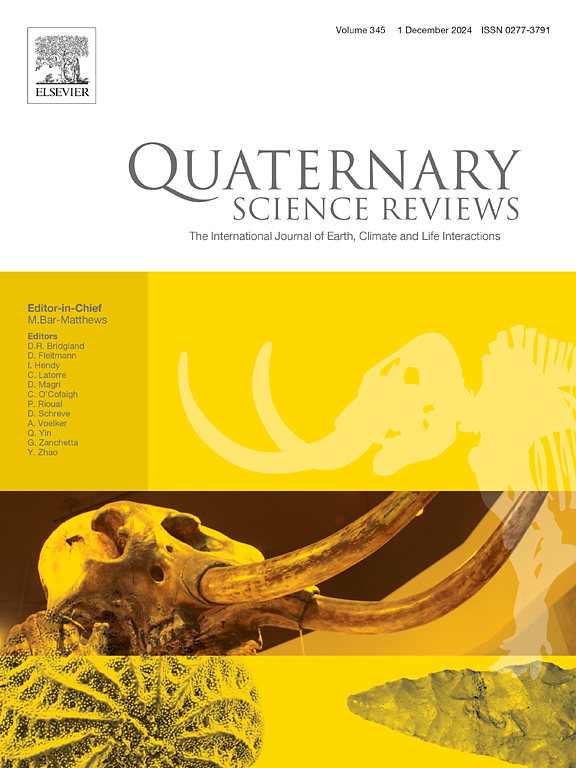靠近阳光还是在地下深处?重建旧石器时代中期Escoural洞穴遗址形成过程的新数据
IF 3.3
1区 地球科学
Q1 GEOGRAPHY, PHYSICAL
引用次数: 0
摘要
探索洞穴系统深层的能力被认为是复杂的人类行为。尼安德特人拥有这项技能的证据仍然有限。位于葡萄牙南部的Escoural遗址以旧石器时代晚期的岩石艺术而闻名于世,这些艺术是在洞穴的最底层进行的。该遗址还在一个深室(P1)和今天位于洞穴外的区域(P2)中保存了旧石器时代中期的序列。由于缺乏地质考古分析,目前还不可能澄清这些材料是否反映了尼安德特人对这些遗址地区的系统访问。在这项研究中,我们综合了地质考古数据和放射性碳定年法来(i)重建遗址形成过程,(ii)探索Escoural地区尼安德特人与食肉动物之间的相互作用。微形态、地层学和年代学结果表明,沉积作用将沉积物和考古发现从上部洞穴室移至P1。这一过程可能混合了分离的和不同的组合,可能导致同时出现高浓度的食肉动物粪化石和石器人工制品。相比之下,P2保留了尼安德特人与食肉动物交替的居住地。尼安德特人的觅食者使用这个区域,当时它是一个靠近原始洞穴入口的大房间,后来由于屋顶坍塌和可能受到现代采石活动的影响而丢失。这些发现与更广泛的欧亚模式一致,表明尼安德特人主要使用光线充足的岩溶洞穴,而不是深而封闭的空间。此外,这项研究强调,沉积后的过程可能对我们对尼安德特人和食肉动物洞穴使用的解释产生深远的影响。本文章由计算机程序翻译,如有差异,请以英文原文为准。
Close to sunlight or deep underground? New data to reconstruct site formation processes at the Middle Paleolithic Escoural cave (southern Portugal)
The ability to exploit the deeper levels of cave systems is regarded as complex human behavior. Evidence that Neanderthals possessed this skill remains limited. The site of Escoural, in southern Portugal, is worldwide renowned for the Upper Paleolithic rock art that was performed in the lowermost level of the cave. The site also preserved Middle Paleolithic sequences in a deep chamber (P1) as well as in an area that today lies outside of the cave (P2). Due to the lack of geoarchaeological analyses, it is currently impossible to clarify whether these materials reflect systematic Neanderthal visits to these site areas. In this study we integrated geoarchaeological data and radiocarbon dating to (i) reconstruct site formation processes, and (ii) explore the interaction between Neanderthals and carnivores at Escoural.
Micromorphological, stratigraphic, and geochronological results demonstrate that colluviation moved sediments and archaeological finds from upper cave chambers into P1. This process likely mixed separate and distinct assemblages, possibly leading to co-occurring high concentrations of carnivore coprolites and lithic artifacts. In contrast, P2 preserves in situ Neanderthal occupations alternating with carnivore visits. Neanderthal foragers used this area when it was a large chamber located close to the original cave entrance, which was subsequently lost due to roof collapses and likely impacted by modern quarrying activities.
These findings align with broader Eurasian patterns indicating that Neanderthals primarily used well-lit karstic cavities rather than deep, enclosed spaces. Moreover, this study underscores that post-depositional processes may have profound impacts on our interpretation of Neanderthal and carnivore cave use.
求助全文
通过发布文献求助,成功后即可免费获取论文全文。
去求助
来源期刊

Quaternary Science Reviews
地学-地球科学综合
CiteScore
7.50
自引率
15.00%
发文量
388
审稿时长
3 months
期刊介绍:
Quaternary Science Reviews caters for all aspects of Quaternary science, and includes, for example, geology, geomorphology, geography, archaeology, soil science, palaeobotany, palaeontology, palaeoclimatology and the full range of applicable dating methods. The dividing line between what constitutes the review paper and one which contains new original data is not easy to establish, so QSR also publishes papers with new data especially if these perform a review function. All the Quaternary sciences are changing rapidly and subject to re-evaluation as the pace of discovery quickens; thus the diverse but comprehensive role of Quaternary Science Reviews keeps readers abreast of the wider issues relating to new developments in the field.
 求助内容:
求助内容: 应助结果提醒方式:
应助结果提醒方式:


